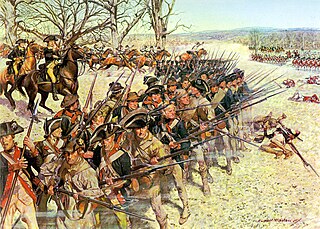
The Battle of Guilford Court House was on March 15, 1781, during the American Revolutionary War, at a site that is now in Greensboro, the seat of Guilford County, North Carolina. A 2,100-man British force under the command of Lieutenant General Charles Cornwallis defeated Major General Nathanael Greene's 4,500 Americans. The British Army, however, suffered considerable casualties.
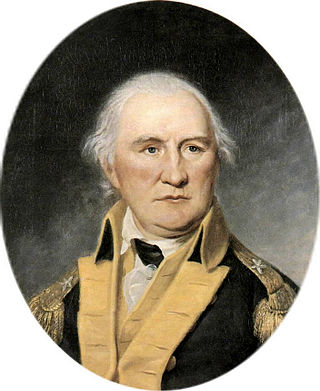
Daniel Morgan was an American pioneer, soldier, and politician from Virginia. One of the most respected battlefield tacticians of the American Revolutionary War of 1775–1783, he later commanded troops during the suppression of the Whiskey Rebellion of 1791–1794.

The Battle of Camden, also known as the Battle of Camden Court House, was a major victory for the British in the Southern theater of the American Revolutionary War. On August 16, 1780, British forces under Lieutenant General Charles, Lord Cornwallis routed the numerically superior U.S. forces led by Major General Horatio Gates about four miles north of Camden, South Carolina, thus strengthening the British hold on the Carolinas following the capture of Charleston.
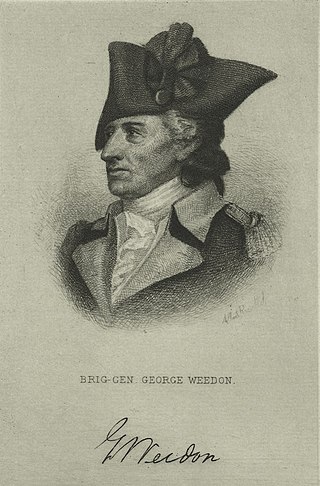
George Weedon (1734–1793) was an American soldier during the Revolutionary War from Fredericksburg, Colony of Virginia. He served as a brigadier general in the Continental Army and later in the Virginia militia. After the Revolutionary War ended he became an original member of the Society of the Cincinnati (Va.).
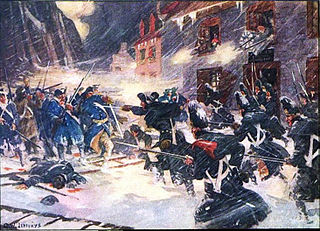
The Battle of Quebec was fought on December 31, 1775, between American Continental Army forces and the British defenders of Quebec City early in the American Revolutionary War. The battle was the first major defeat of the war for the Americans, and it came with heavy losses. General Richard Montgomery was killed, Benedict Arnold was wounded, and Daniel Morgan and more than 400 men were taken prisoner. The city's garrison, a motley assortment of regular troops and militia led by Quebec's provincial governor, General Guy Carleton, suffered a small number of casualties.

Edward Carrington was an American soldier and statesman from Virginia. During the American Revolutionary War he became a lieutenant colonel of artillery in the Continental Army. He distinguished himself as quartermaster general in General Nathanael Greene’s southern campaign. He commanded artillery at Monmouth and Yorktown. He was also present at Cowpens, Guilford Court House, and Hobkirk's Hill. During the war he became a close friend of George Washington. Carrington served in the 3rd Continental Congress and was the first US Marshal appointed from his state. He was an original member of the Society of the Cincinnati.
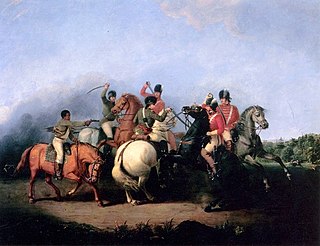
The Battle of Cowpens was an engagement during the American Revolutionary War fought on January 17, 1781 near the town of Cowpens, South Carolina, between U.S. forces under Brigadier General Daniel Morgan and British forces under Lieutenant Colonel Banastre Tarleton, as part of the campaign in the Carolinas. The battle was a turning point in the American reconquest of South Carolina from the British.

The Battle of Great Bridge was fought December 9, 1775, in the area of Great Bridge, Virginia, early in the American Revolutionary War. The victory by colonial Virginia militia forces led to the departure of Royal Governor Lord Dunmore and any remaining vestiges of British power over the Colony of Virginia during the early days of the conflict.
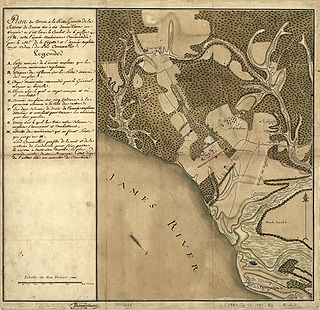
The Battle of Green Spring took place near Green Spring Plantation in James City County, Virginia during the American Revolutionary War. On July 6, 1781 United States Brigadier General "Mad" Anthony Wayne, leading the advance forces of the Marquis de Lafayette, was ambushed near the plantation by the British army of Earl Charles Cornwallis in the last major land battle of the Virginia campaign prior to the Siege of Yorktown.
The 3rd Maryland Regiment was an infantry regiment of the Continental Army during the American Revolutionary War. It served from 1776 to 1783, mostly in the Middle Atlantic Region of the conflict.
The 2d Virginia Regiment was authorized by the Virginia Convention, July 17, 1775, as a force of regular troops for the Commonwealth's defense. It consisted of seven companies, 476 privates and the usual regimental officers. William Woodford, of Caroline County, named colonel, along with Lieutenant Colonel Charles Scott and Major Alexander Spotswood were the regiment's initial field officers. Virginia had been divided into 16 military districts which took their names from the predominant county in the grouping; for instance, Prince William District included Fairfax and Loudoun Counties as well. Col. Gregory Smith 1777-78 Col Brent 1779
The 8th Virginia Regiment or German Regiment was an infantry unit that served in the Continental Army during the American Revolutionary War. Authorized in January 1776, the regiment was raised from men of several northwestern counties in the strength of 10 companies. Its first commander was Colonel Peter Muhlenberg, a clergyman and militia leader. The unit marched to defend Charleston, South Carolina in 1776, but saw no fighting. At the start of 1777, the 8th Virginia moved to join George Washington's main army. When Muhlenberg was promoted to general officer, Colonel Abraham Bowman took command of the unit.
The 2nd North Carolina Regiment was an American infantry unit that was raised for the Continental Army during the American Revolutionary War. In 1776 the regiment helped defend Charleston, South Carolina. Ordered to join George Washington's main army in February 1777, the regiment subsequently fought at Brandywine and Germantown during the Philadelphia Campaign. After most other North Carolina regiments were sent home to recruit, the 1st and 2nd Regiments remained with the main army and fought at Monmouth in June 1778. The regiment was transferred to the Southern Department and was captured by the British army in May 1780 at the Siege of Charleston. Together with the 1st Regiment, the unit was rebuilt and fought capably at Eutaw Springs. The 2nd was furloughed in April 1783 and officially dissolved in November 1783.

The siege of Yorktown was the culminating act of the Yorktown campaign, a series of military operations occupying much of 1781 during the American Revolutionary War. The siege was a decisive Franco-American victory: after the surrender of British Lt. Gen. Charles, Earl Cornwallis on October 17, the government of Lord North fell, and its replacement entered into peace negotiations that resulted in British recognition of American independence with the 1783 Treaty of Paris.

The Queen's Rangers, also known as the Queen's American Rangers, and later Simcoe's Rangers, were a Loyalist military unit of the American Revolutionary War. Formed in 1776, they were named for Queen Charlotte, consort of George III. The Queen's Rangers served as a light corps in the tradition of British rangers during the Seven Years' War, operating on the flanks and in advance of Crown forces, manning outposts, conducting patrols, and carrying out reconnaissance and raiding operations.
William "Billy" Flora was a free-born African American from Virginia who served as a soldier on the Patriot side in the American Revolutionary War. He fought under Colonel William Woodford in the Battle of Great Bridge in December 1775, where he is widely acknowledged as the hero of the battle. A sentry at the bridge reported he was the last to cross as the British advanced. As he retreated from his post, under heavy fire from the British line, he ripped up a plank from the bridge. This made the British crossing, under fire from the colonials, impossible. As a result, the British were forced to withdraw to their ships. The only casualty on the American side survived to speak very highly of Flora and his courage.
The 4th Continental Artillery Regiment, also known as Reign’s Continental Artillery Regiment, was an American military unit during the American Revolutionary War. The regiment became part of the Continental Army on 10 June 1777 as Colonel Thomas Proctor's Continental Artillery Regiment. It was made up of eight artillery companies from eastern Pennsylvania. At the time of the regiment's formation, two companies were already in existence, one from as early as October 1775. One company served at Trenton in December 1776 where it performed well in action. In February 1777, Pennsylvania expanded its two-company battalion into an eight-company regiment. After officially joining the Continental Army, the regiment saw much fighting in the Philadelphia campaign in late 1777. Elements of Proctor's Regiment fought at Monmouth in June 1778 and joined the Sullivan Expedition in summer 1779.

Walter Stewart was an Irish-born American general in the Continental Army during the American Revolutionary War.
Richard Parker was an American colonel who fought in the American Revolutionary War. Son of prominent Virginia jurist Richard Parker, Parker received an officer's commission in a Virginia regiment early in the conflict. He probably was present at Great Bridge and Norfolk. Promoted to major, he fought at Trenton in December 1776 and commanded the regiment at Second Trenton and Princeton in January 1777. At Brandywine in September 1777 he led a detachment of light infantry in delaying the British. The next month he fought at Germantown. Promoted to colonel at Valley Forge, he led a picked detachment at Monmouth in June 1778. In May 1779, George Washington ordered him back to Virginia to recruit a new regiment. After being sent south with a new unit of reinforcements for Charleston, South Carolina in late 1779, he died of wounds received at the Siege of Charleston in 1780.











